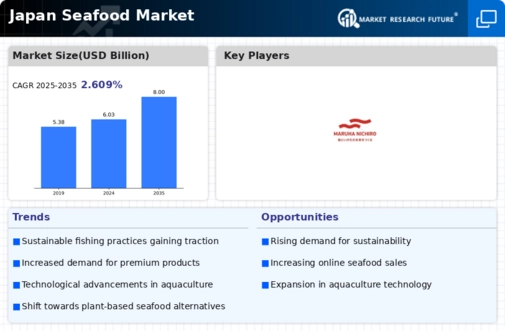Rising Consumer Demand for Seafood
The seafood market in Japan experiences a notable increase in consumer demand, driven by a growing appreciation for diverse seafood options. This trend is reflected in the rising per capita consumption of seafood, which reached approximately 25 kg in recent years. The Japanese population's inclination towards fresh and high-quality seafood products contributes to this demand. Additionally, the increasing awareness of the nutritional benefits associated with seafood, such as omega-3 fatty acids, further fuels this growth. As consumers become more health-conscious, the seafood market is likely to see a shift towards premium and sustainably sourced products, indicating a potential for higher price points and profit margins.
Technological Advancements in Seafood Processing
Technological innovations play a crucial role in enhancing the efficiency and quality of seafood processing within the seafood market. Advanced processing techniques, such as vacuum packaging and cryogenic freezing, are increasingly adopted to preserve freshness and extend shelf life. These technologies not only improve product quality but also reduce waste, which is particularly important in a market where freshness is paramount. Furthermore, automation in processing facilities is likely to streamline operations, potentially lowering production costs. As Japan continues to prioritize food safety and quality, the integration of technology in seafood processing may lead to a more competitive seafood market, catering to both domestic and international demands.
Impact of Aging Population on Seafood Consumption
Japan's aging population presents both challenges and opportunities for the seafood market. As the demographic landscape shifts, there is a growing need for convenient and easy-to-prepare seafood products that cater to older consumers. This demographic is likely to favor ready-to-eat meals and processed seafood items, which could lead to a transformation in product offerings. Furthermore, the health benefits associated with seafood consumption, such as improved heart health, resonate with older adults, potentially driving demand. The seafood market may need to adapt its strategies to meet the preferences of this demographic, ensuring that it remains relevant and competitive in an evolving market.
Regulatory Framework and Sustainability Practices
The seafood market in Japan is shaped by a robust regulatory framework aimed at promoting sustainable fishing practices. Government initiatives and policies encourage responsible sourcing and management of marine resources, which is crucial for the long-term viability of the market. The implementation of quotas and fishing licenses helps to prevent overfishing, ensuring that seafood stocks remain healthy. Additionally, consumer awareness regarding sustainability is on the rise, prompting businesses to adopt eco-friendly practices. This shift towards sustainability not only aligns with The seafood market, potentially attracting environmentally conscious consumers and investors.
Cultural Significance of Seafood in Japanese Cuisine
Seafood holds a central place in Japanese culinary traditions, significantly influencing the seafood market. The cultural importance of dishes such as sushi, sashimi, and tempura drives consistent demand for various seafood products. This cultural affinity is reflected in the market's resilience, as seafood remains a staple in Japanese households and restaurants. The ongoing popularity of traditional seafood dishes, coupled with the emergence of fusion cuisine, suggests that the seafood market will continue to thrive. Moreover, the emphasis on seasonal seafood consumption aligns with Japan's rich fishing heritage, potentially leading to increased interest in locally sourced products and artisanal seafood offerings.












Leave a Comment